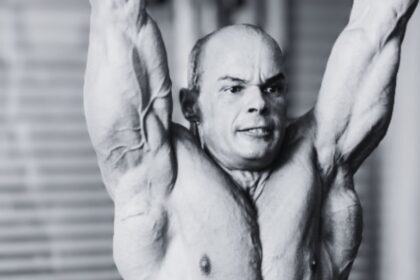Simone Biles Opens Up About the Impact of Husband Jonathan Owens’ Viral Interview
Simone Biles, the celebrated gymnast and Olympic champion, recently revealed the emotional…
“Rest in peace” – NFL Mourns Chris Mortensen: Peyton Manning Leads Tributes to Iconic Reporter ‘Heartbroken’
The NFL community is mourning the loss of one of its most…
Bodybuilding Community Mourns Loss of Neil Currey at 34: Parents Blame Steroids for His Death
The bodybuilding world was rocked by tragedy with the untimely death of…
Rest In Peace: Marco Luis, Aged 46, Known as ‘The Monster’
The bodybuilding world is in mourning following the tragic passing of Marco…
Brad Pitt’s Girlfriend Ines de Ramon, 34, Stars in New Modeling Campaign Amid Rumors of Love with the Actor
In a recent development, Brad Pitt's girlfriend, Ines de Ramon, 34, has…
Heartfelt Support Pours in for Giants Legend Michael Strahan After Heartbreaking Family News – “Praying for his family”
Former NFL star Michael Strahan and his family are facing a challenging…
Boxing Star Ryan Garcia’s Controversial Exit from New York Mets’ Stadium Sparks Twitter Rant
In a dramatic turn of events, boxing sensation Ryan Garcia found himself…
Rick Ross Faces Accusations of Misrepresenting Past Employment as Correctional Officer
Rapper Rick Ross finds himself embroiled in controversy once again as allegations…
50 Cent Reacts to Outlandish Rumors Surrounding Diddy and Carl Winslow
In a bizarre turn of events, rapper and entrepreneur 50 Cent has…
Trevor Lawrence Discusses Potential Contract Extension with Jaguars
As Trevor Lawrence wraps up his third season with the Jacksonville Jaguars,…
“RIP Brother”: Paralyzed WWE Legend and NFL Star Passed Away at 54 Due to Natural Causes – Dwayne Johnson Joins Millions of Heartbroken WWE Fans in Mourning
The wrestling community remembers the passing of former WWE wrestler Darren 'Droz'…
Michigan Wolverines Football Program Under Fire for Recruiting Violations During Jim Harbaugh’s Tenure
The revelation of multiple recruiting violations during Jim Harbaugh's tenure as head…
“Love’s Resurgence: Ashanti & Nelly’s Joyful Revelation of Engagement and Parenthood!”
In a heartfelt revelation, singer Ashanti, 43, has announced her pregnancy and…
“Pirates’ Star Closer Aroldis Chapman Benched: MLB Drops the Hammer After Umpire Dispute”
The Pittsburgh Pirates face a tough blow as their star closer, Aroldis…
“Pamela Anderson Dives into Remake Realm: Swaps Baywatch for Naked Gun!”
The buzz surrounding remakes is often met with mixed emotions, but Pamela…
“Michael Strahan’s Daughter Sophia Defends Sister Isabella Amid Cancer Battle”
Sophia Strahan, daughter of former NFL star Michael Strahan, has emerged as…
“Legal Storm Brews for Rashee Rice and Teddy Knox: $10M Lawsuit Filed Over Multi-Vehicle Crash”
Rashee Rice and Teddy Knox find themselves embroiled in a legal battle…
“Shaquille O’Neal Decries Caitlin Clark’s Rookie Contract: Calls for Support in Women’s Basketball”
Basketball icon Shaquille O'Neal has joined the chorus of voices expressing dismay…
Shocking Tragedy: Doctor’s Fatal Mistake Stuns Family and Sparks Outrage
In a devastating turn of events, a routine childbirth procedure turned into…
“R.I.P”: ‘Tetra Pak Heir’s Second Wife’s Tragic End’
Julia Rausing, the devoted philanthropist and adored wife of Tetra Pak heir…
“49ers’ Shocking Draft Move: First Round Return Sparks Controversy and Intrigue”
SANTA CLARA, Calif. After two years of draft night silence, the San Francisco…
“Josh Allen’s Shocking Revelation: The Real Force Behind His Success Revealed!”
Bills' Josh Allen Reflects on the Impact of Stefon Diggs Orchard Park,…
Deion Sanders Denies Reports of NFL Team Preference for His Sons: “That’s a Stupid Lie”
A Closer Look at the Controversy Surrounding Sanders' Alleged List Deion Sanders,…
“NFL Shocker: Ravens WR Zay Flowers Cleared in Domestic Assault Probe – What Really Happened?”
Ravens WR Zay Flowers Cleared of Allegations Baltimore Ravens wide receiver Zay…
“Lions’ Shocking Rebirth: Dan Campbell’s Black Jersey Deal Revealed”
Detroit Lions’ Nostalgic Nod In a move that sparked both nostalgia and…
“NFL’s Most Shocking Draft Busts: The 50 Infamous Selections That Haunt Teams to This Day”
Well, the NFL draft never fails to generate excitement and anticipation, but…
“Sheamus Shocks WWE: Controversial Return Raises Eyebrows!”
In a stunning turn of events, the WWE Universe witnessed the long-awaited…
WrestleMania 41: Mystery Venue Revealed?
A Venue in Limbo The wrestling world is abuzz with speculation as…
“Matt Hardy’s Wrestling Odyssey: AEW Departure Sparks WWE Buzz”
Wrestling World Buzzes as Hardy's AEW Contract Comes to a Close In…
“Rest in Peace” Hulk Hogan’s Twitter Blunder: Mistaken Tribute Sparks Controversy Over Celebrity Death
In the world of social media, even the biggest celebrities aren't immune…
End of an Era? Shaq Sounds Alarm – Lakers’ Playoff Fate May Determine LeBron James’ Future with Team
In a gripping start to the Western Conference Play-in round, the Los…
“Just Keeps Talking… Instead of Winning”: Aaron Rodgers Under Fire: Fans Question His Loyalty Amidst Media Tours Instead of Field Focus
Aaron Rodgers, the enigmatic figure of the NFL, has once again found…
Aaron Rodgers Unleashes Fury: Accuses Media of Exploitation, Friendship Betrayal, and Unreturned Favors
Rodgers Opens Up on Exploitation and Friendship In a candid three-hour conversation…
Tragic Loss Strikes ‘Harry Potter’ Star Warwick Davis’ Wife Samantha Davis Passes Away at 53, says, “I miss her hugs”
Heartbreak in Hollywood: Warwick Davis Mourns the Loss of Wife Samantha!
New Balance Unveils Star-Studded Ad featuring Jamal Murray, Coco Gauff, Shohei Ohtani as Tennis Sensation Takes Center Stage!
Coco Gauff Takes Center Stage Alongside Sports Icons like Jamal Murray in…
LeBron James’ Fearless Act Leaves NBA Fans in Awe! “A 40 YEAR OLD SHOULDN’T BE DOING THAT”
NBA's Veteran versus Rising Star: LeBron James Stands firm Against Zion Williamson's…
Caitlin Clark’s Nike Deal Signals Shift in Women’s Basketball: How Caitlin Clark’s Deal with Nike Contrasts LeBron James’ Rookie Contract
Caitlin Clark's Rookie Deal Unveils Stark Disparity in Basketball In the domain…
“R.I.P,” “A Guitar Legend”: Dickey Betts of the Allman Brothers Band Passes Away at 80
Remembering Dickey Betts: The End of an Era for Rock and Roll!
“I’m a fighter and I’m not giving up”: Peter Frampton’s Inspirational Battle Against Degenerative Disease
Peter Frampton: The Fighter Who Refuses to Quit Amidst Disease!
Love in the Ring: “Ryan Garcia’s Rollercoaster Romance Journey with Savannah Bond”
Ring of Fire: Ryan Garcia's Engagement to Aussie Star Sparks Controversy and…
Fashion Police Alert “USA’s Are Terrible” Stephen Curry & Lebron James’ Team USA Olympic Outfit Roasted by Fans
Fans Critique Team USA's Olympic Outfit Ahead of Paris 2024 Games As…
NBA Legend Gifts 13 MacBook Pros to Poverty-Stricken School: Shaq Scores Big in Education
Shaquille O'Neal, the transcending figure both on and off the b-ball court,…
Goodbye to Greatness “Love You Geezy” NBA Icon Bids Farewell & Stuns Jamal Crawford & NBA World in Emotional Retirement
In a sincere declaration that resounded through the b-ball world, Blake Griffin,…
“R.I.P”: Cristiano Ronaldo Reflects on Tragic Loss While Celebrating Daughter’s 2nd Birthday
Amidst the glitz and glamour of Cristiano Ronaldo's illustrious career, there exists…
Tragic Turn: Personal Trainer’s Wellness Retreat Ends in Suspected Mushroom Poisoning
Fatal Fungi: Mother and Trainer's Retreat Takes a Deadly Turn!
“R.I.P, young fella gone too soon for sure”: Heartbreak Before the Draft – NFL Prospect AJ Simon’s Passing Leaves a Void
In a stunning and heartbreaking turn of events, the football world reels…
“OUR RAY OF SUNSHINE:” Tragic Loss of Pearl Unu-Arubi age 12, died at school
Unveiling Pearl's Last Moments: A School's Heartbreaking Vigil!
“R.I.P” ‘This one hurts to write, the world lost a creative genius’ – A Loss That Will Never Fade
Renowned fashion icon Karl Lagerfeld passed away this week in Paris at…
Kelly Clarkson’s Emotional Breakdown Over Difficulties During Pregnancy Draws Mixed Reactions
Kelly Clarkson: Expressing the Anguish of Challenging Pregnancy A Touching Disclosure: Clarkson's…
Tess Holliday Addresses ‘Fatphobic’ Messages Amid Mental Health Struggles
Tess Holliday: Confronting Fatphobia and Accepting Your True Self Handling fatphobia: Holliday's…



















































